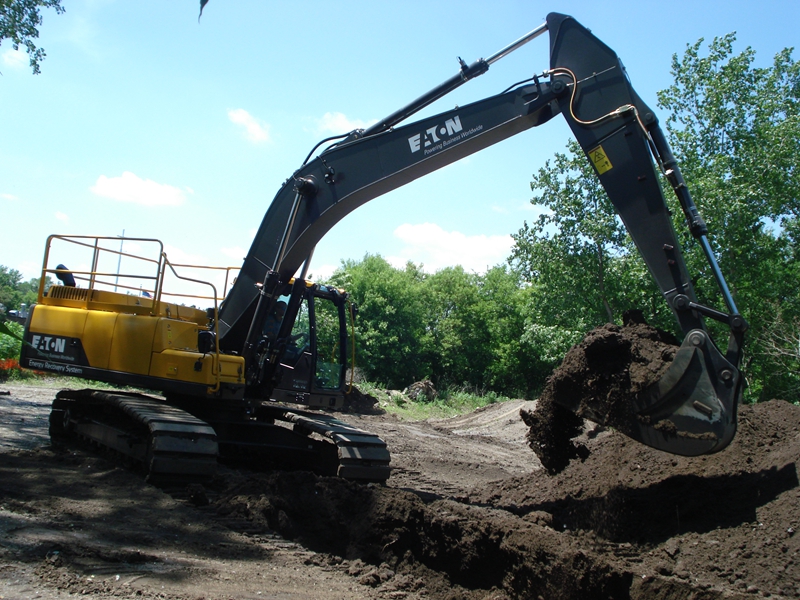 伊顿的液压混合动力系统,将给其他电动混动系统带来巨大的挑战。
伊顿的液压混合动力系统,将给其他电动混动系统带来巨大的挑战。
车辆动力系统的电气化技术,在包括巴士和小型车辆在内的很多领域都实现了成绩不俗的商业应用。但在其他一些领域,电动系统还不够成功。混合动力技术本是一种相当经济的解决方案,但目前低廉的油价,使这项技术的推广变得比较困难。
与一些大型工程机械或农机设备相比,多数电动非公路设备都相对较小,其功率需求也不高,因而更适合采用混合动力系统。
“在非公路设备领域,纯电动模式好像是小型机械的专利,只适用于那些功率不到19kW的设备。”FEV North America公司动力系统总监Kiran Govindswamy表示,“而混合动力技术则支持多种不同模式,比如微混(Micro)、轻混(Mild)和全混(Full)等,因此应用最为广泛。究其根本原因,主要是加装电池的成本较高,且电池充电所需的停工等待时间也较长。”
在任何领域内,电动系统都必须面对液压混合动力系统的挑战。与液压元件相比,电池组所占的空间更大。虽然混合动力车的确推动了电池领域的发展,但多数厂商还是更倾向于使用“久经沙场”的液压混动系统,而非选择对现有产品线进行大规模改造。
“加装电动架构,会增加设备的生产成本和复杂度。”卡特彼勒(Caterpillar)高级元件与系统部首席工程师、液压专家Randy Peterson认为,“液压混合动力系统与电动系统的功率密度比大约仍在10:1左右,这会给电动系统的安装增加一定的挑战。”
此外,很多应用需要快速输出大量功率,而电机很难做到这一点。在很多情况下,电动系统中的电池充放电速度有限,也会阻碍这种系统的推广。
“随着电池技术的不断进步,其能源储存与使用的能力也愈加出色,”伊顿(Eaton)旗下Hydraulics Group的技术研发总监Steve Zumbusch表示,“如果能量消耗速度(功率)过高,那电池的快速充放电就成了一项必须达到的目标。而与此相比,液压混动系统却有非常明显的优势,比如说,其蓄电池可以极为快速地进行充放电,并提供非常高的功率。”
不过,虽然当下的电池功率仍有局限,但未来也颇具发展的潜力。汽车领域的取得的进展可以降低整个系统的成本,而且谁也无法保证,全球油价将一直保持低位。此外,未来可能出台的法规政策,也会提起人们对混合动力系统的兴趣。
“短期来看,低廉的油价会使电动系统的投资回收更慢,”Govindswamy表示,“目前除了挖掘机,其他电动系统的投资回报速度都并不理想。不过,由于加装混合动力系统的成本已经大幅降低,而且目前油价也略有抬头的迹象,混合动力系统的投资回报期将更加趋于合理。”
作者:Terry Costlow
来源:SAE《非公路工程》杂志
翻译:SAE上海办公室
Electrified off-highway powertrains search for marketing power
Electrified powertrains have seen success in commercial applications like buses and small vehicles, but in many fields, they’ve seen only limited success. Today’s low fuel prices are not helping marketers expand the niches where hybrids provide a cost-effective solution.
Most electric off-highway vehicles are relatively small vehicles that have small power requirements compared to some construction and agriculture behemoths. Hybrids fit more use cases.
“For non-road mobile machinery applications, a pure electric mode of operation is only relevant for small machines, less than 19 kW,” said Kiran Govindswamy, Powertrain Director at FEV North America. “Only hybrid concepts, from micro to mild and full hybrids, are considered to be feasible for most applications. This is fundamentally driven by high add-on costs for batteries as well as time needed for recharging the batteries.”
In all vehicle classes, electrified powertrains face competition from hydraulic hybrids. Battery packs take a fair amount of space compared to hydraulic components. Automotive hybrids are driving advances in batteries, but many developers feel it’s easier to use battle-tested hydraulics than to revamp systems on existing product lines.
“Adding an electric power architecture adds cost and complexity that the base machine doesn't normally have,” said Randy Peterson, Chief Engineer, Hydraulics, at Caterpillar Advanced Components & Systems Division. “The power density (size) advantage for hydraulics over electrics is still in the neighborhood of 10:1 or more, making packaging electrics a challenge.”
Many usage models require quick bursts of power that can be difficult to provide with electric motors. Battery discharge and charging rates can work against electrics in many environments.
“As battery technology continues to improve, the ability to store and use energy becomes much more attractive,” said Steve Zumbusch, Technology Development Director for Eaton’s Hydraulics Group. “If the rate of energy consumption (power) becomes high, then the battery technology becomes challenged with being able to rapidly store and discharge energy fast enough to be effective. Hydraulics on the other hand, have a very distinct advantage in using technologies such as accumulators that can be charged and discharged extremely fast, providing very high power levels.”
Though battery power has limits, its role may still expand. Advances in automotive are driving down overall system costs, and there’s no guarantee that global oil prices will remain low. Potential regulatory restrictions are also prompting a lot of research into hybrids.
“The low cost of fuel has negatively influenced the payback period,” Govindswamy said. “With the exception of large excavators, electrified powertrain payback times currently remain rather poor. Considering significantly reduced hybrid add-on costs as well as a slight increase in fuel price, hybridization with reasonable payback periods are expected to become feasible in the future.”
Author: Terry Costlow
Source: SAE Off-Highway Engineering Magazine
等级
打分
- 2分
- 4分
- 6分
- 8分
- 10分
平均分
- 作者:Terry Costlow
- 行业:汽车
- 主题:动力与推进力
